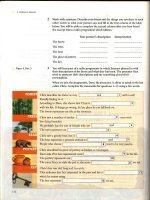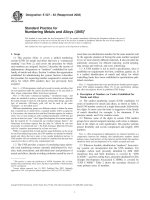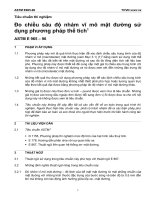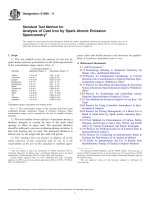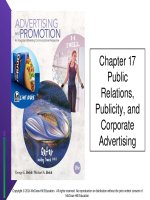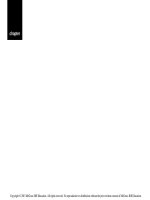Astm e 1388 17
Bạn đang xem bản rút gọn của tài liệu. Xem và tải ngay bản đầy đủ của tài liệu tại đây (71.15 KB, 3 trang )
This international standard was developed in accordance with internationally recognized principles on standardization established in the Decision on Principles for the
Development of International Standards, Guides and Recommendations issued by the World Trade Organization Technical Barriers to Trade (TBT) Committee.
Designation: E1388 − 17
Standard Practice for
Static Headspace Sampling of Vapors from Fire Debris
Samples1
This standard is issued under the fixed designation E1388; the number immediately following the designation indicates the year of
original adoption or, in the case of revision, the year of last revision. A number in parentheses indicates the year of last reapproval. A
superscript epsilon (´) indicates an editorial change since the last revision or reapproval.
from Fire Debris Samples by Passive Headspace Concentration With Activated Charcoal
E1413 Practice for Separation of Ignitable Liquid Residues
from Fire Debris Samples by Dynamic Headspace Concentration
E1459 Guide for Physical Evidence Labeling and Related
Documentation
E1492 Practice for Receiving, Documenting, Storing, and
Retrieving Evidence in a Forensic Science Laboratory
E1618 Test Method for Ignitable Liquid Residues in Extracts
from Fire Debris Samples by Gas Chromatography-Mass
Spectrometry
E2154 Practice for Separation and Concentration of Ignitable Liquid Residues from Fire Debris Samples by Passive Headspace Concentration with Solid Phase Microextraction (SPME)
E2451 Practice for Preserving Ignitable Liquids and Ignitable Liquid Residue Extracts from Fire Debris Samples
1. Scope
1.1 This practice describes the procedure for removing
vapor from the headspace of a fire debris container for the
purpose of detecting or identifying ignitable liquid residues.
1.2 Separation and concentration procedures are listed in the
referenced documents. (See Practices E1386, E1412, E1413,
and E2154.)
1.3 This practice offers a set of instructions for performing
one or more specific operations. This standard cannot replace
knowledge, skill, or ability acquired through appropriate
education, training, and experience and should be used in
conjunction with sound professional judgment.
1.4 The values stated in SI units are to be regarded as
standard. No other units of measurement are included in this
standard.
1.5 This standard does not purport to address all of the
safety concerns, if any, associated with its use. It is the
responsibility of the user of this standard to establish appropriate safety and health practices and determine the applicability of regulatory limitations prior to use.
1.6 This international standard was developed in accordance with internationally recognized principles on standardization established in the Decision on Principles for the
Development of International Standards, Guides and Recommendations issued by the World Trade Organization Technical
Barriers to Trade (TBT) Committee.
3. Summary of Practice
3.1 The headspace of an item is sampled, preferably in its
original container, for analysis by an appropriate technique (for
example, gas chromatography-mass spectrometry). The container may be heated prior to sampling to increase the volatility
of any ignitable liquid residues.
4. Significance and Use
4.1 This practice is useful for sampling fire debris to screen
for the presence of ignitable liquid residues prior to extraction
with other techniques. It is most appropriate for sampling light
to medium range ignitable liquids (such as light oxygenates,
lacquer thinners, and other similar volatile compounds or
products), and less appropriate for sampling ignitable liquids
that have compounds in the heavy range.3, 4, 5
4.1.1 When sampled for screening purposes, the instrumentation typically utilized is a gas chromatograph with either a
2. Referenced Documents
2.1 ASTM Standards:2
E1386 Practice for Separation of Ignitable Liquid Residues
from Fire Debris Samples by Solvent Extraction
E1412 Practice for Separation of Ignitable Liquid Residues
1
This practice in under the jurisdiction of ASTM Committee E30 on Forensic
Sciences and is the direct responsibility of Subcommittee E30.01 on Criminalistics
Current edition approved July 15, 2017. Published July 2017. Originally
approved in 1990. Last previous edition approved in 2012 as E1388 – 12. DOI:
10.1520/E1388-17.
2
For referenced ASTM standards, visit the ASTM website, www.astm.org, or
contact ASTM Customer Service at For Annual Book of ASTM
Standards volume information, refer to the standard’s Document Summary page on
the ASTM website.
3
Ettling, B. V., and Adams, M. F., “The Study of Accelerant Residues in Fire
Remains,” Journal of Forensic Sciences, Vol 13, No. 1, 1968, pp. 76–89.
4
Stauffer, E., Dolan, J. A., and Newman, R., Fire Debris Analysis, Boston, MA:
Academic Press, 2008.
5
Hinshaw, J. V., “Headspace Sampling,” LCGC Europe, Vol 24, No. 10, 2011.
Copyright © ASTM International, 100 Barr Harbor Drive, PO Box C700, West Conshohocken, PA 19428-2959. United States
1
E1388 − 17
6.2 Prepare the sample or evidence container for headspace
sampling.
6.2.1 Create a hole in the container lid such that a syringe
needle can be introduced. Seal the hole with tape, a rubber
sleeve stopper, or as otherwise required. Alternatively, crack
the container lid to allow a syringe needle to be introduced and
close following sampling.
mass spectrometer (GC-MS, refer to Test Method E1618) or
flame ionization detector (GC-FID).
4.2 This practice is generally less efficient at recovering
limited quantities of ignitable liquids than Practices E1386,
E1412, E1413, and E2154, particularly for higher boiling
compounds.
4.3 The separation takes place in a closed container and the
sample remains in approximately the same condition in which
it was submitted. Since only a small aliquot of the sample
headspace is removed for analysis, sample reanalysis may be
possible.
NOTE 2—Some cans designed for fire debris samples contain lids
having rubber sleeve stoppers already in place.
6.2.2 Some samples, such as liquids, may be transferred and
sealed into vials for analysis without any further preparation.
6.2.3 Prepare control samples and blanks for sampling using
the same procedures used for questioned samples as required
per laboratory policies.
4.4 High concentrations of highly volatile compounds can
saturate the headspace, inhibiting the recovery of less volatile
components and leading to the detection or identification of
only the more volatile compounds in the sample.
6.3 If heating is required, place the container in the heating
system until the container reaches the desired temperature and
remove immediately prior to sampling. Record the temperature
and duration of heating.
6.3.1 Sampling at room temperature is appropriate to recover the more volatile compounds. Sampling at elevated
temperatures, typically between 60°C and 90°C, is necessary to
recover compounds with lower volatility.
4.5 This practice is intended for use in conjunction with
other extraction techniques, such as those described in Practices E1386, E1412, E1413, and E2154, when analysis of a
sample for all classes of ignitable liquids is required or desired.
NOTE 1—The headspace specimen (the portion in the syringe) is
consumed in the analysis. Preserve an extract for potential reanalysis (see
Practice E2451) using an alternative separation and concentration
practice, such as those described in Practices E1386, E1412, and E1413,
if preservation is required per laboratory policies.
NOTE 3—When other evidentiary considerations arise (such as DNA or
latent print examinations), consult with other relevant analyst(s) prior to
heating samples.
5. Apparatus
7. Sampling Procedure
5.1 Heating System—An oven or equivalent, capable of
reproducible temperature operation for the desired range that
can accommodate the evidence container.
5.1.1 An oven is recommended to achieve a constant
temperature throughout the system.
7.1 Headspace Sampling for Manual Injection:
7.1.1 Assemble a syringe and needle (sampling syringe) as
needed. The syringe should be heated to the sampling temperature prior to sampling.
7.1.2 Withdraw between 0.5 to 2.0 mL of headspace from
the evidence container into a sampling syringe.
7.1.2.1 Sample from an area above the fire debris in the
evidence container.
7.1.3 Immediately analyze the specimen using an appropriate instrumental technique (for example, gas chromatographymass spectrometry).
7.1.4 After sampling, reseal the evidence container as
needed or prepare as necessary for any additional analyses to
include other fire debris extraction techniques.
7.1.5 Perform sampling on control samples and blanks
following the same procedures used for questioned samples as
required in accordance with laboratory policies.
5.2 Temperature Measuring Device—A thermometer or
thermocouple capable of measuring temperatures in the required range of operation.
5.3 Disposable or reusable gas-tight syringes, capable of
reproducibly sampling in the range from 0.5 to 2.0 mL.
5.4 Disposable or reusable syringe needles.
5.5 Gas-tight vials and caps.
5.6 A tool or device capable of creating holes in evidence
containers (for example, drill, hole punch, hammer and nail).
5.7 Tape, rubber sleeve stoppers, or equivalent, capable of
sealing holes in evidence containers.
6. Sample Preparation
7.2 Headspace Sampling for Automated Injection System:
7.2.1 Some sample injection systems utilize headspace vials
for delivery of a sample headspace into the gas chromatograph.
7.2.2 Assemble and seal (for example, crimp or screw) cap
onto headspace vial.
7.2.3 Assemble a syringe and needle (sampling syringe) as
needed to be used for evacuating the sealed headspace vial and
removing headspace samples from an evidence container.
7.2.3.1 Syringe size (volume capacity) may vary but the
sampling syringe should have approximately the same or
greater volume capacity as the vials.
6.1 Observe the appropriate procedures for handling and
documentation of all submitted samples as described in Guide
E1459 and Practice E1492.
6.1.1 Examine the fire debris sample to determine that it is
consistent with its description prior to reporting. The examination may be performed prior to or after the sampling
procedure in Section 7.
6.1.1.1 Resolve any discrepancies between the submitting
agency’s description of the evidence and the analyst’s observation prior to the completion of the report.
2
E1388 − 17
7.2.4 Evacuate a portion of the sealed vial using the
sampling syringe. Repeat this procedure until the equivalent of
at least twice the volume capacity of the vial has been
evacuated.
headspace sample into the vial. Any subsequent sampling and transfer
could require some effort to push the contents of the sampling syringe into
the vial.
7.2.7 Immediately analyze specimens, using an appropriate
instrumental technique (for example, gas chromatographymass spectrometry).
7.2.8 After sampling, reseal the container as needed or
prepare as necessary for any additional analyses to include
other fire debris extraction techniques.
7.2.9 Perform sampling on control samples and blanks
following the same procedures used for questioned samples as
required in accordance with laboratory policies.
NOTE 4—A needle assembly attached directly to a vacuum source may
be used to evacuate the vial as an alternative to using a sampling syringe.
7.2.5 Withdraw a sample of the headspace above the fire
debris from the evidence container using a sampling syringe.
7.2.6 Immediately transfer the contents of the sampling
syringe into the evacuated vial. Repeat this process until the
injected volume of headspace from the evidence container
approximates the volume previously evacuated from the vial.
8. Keywords
NOTE 5—If the vial was properly sealed and evacuated, the vacuum
created should pull the contents of the sampling syringe of the initial
8.1 fire debris samples; headspace
ASTM International takes no position respecting the validity of any patent rights asserted in connection with any item mentioned
in this standard. Users of this standard are expressly advised that determination of the validity of any such patent rights, and the risk
of infringement of such rights, are entirely their own responsibility.
This standard is subject to revision at any time by the responsible technical committee and must be reviewed every five years and
if not revised, either reapproved or withdrawn. Your comments are invited either for revision of this standard or for additional standards
and should be addressed to ASTM International Headquarters. Your comments will receive careful consideration at a meeting of the
responsible technical committee, which you may attend. If you feel that your comments have not received a fair hearing you should
make your views known to the ASTM Committee on Standards, at the address shown below.
This standard is copyrighted by ASTM International, 100 Barr Harbor Drive, PO Box C700, West Conshohocken, PA 19428-2959,
United States. Individual reprints (single or multiple copies) of this standard may be obtained by contacting ASTM at the above
address or at 610-832-9585 (phone), 610-832-9555 (fax), or (e-mail); or through the ASTM website
(www.astm.org). Permission rights to photocopy the standard may also be secured from the Copyright Clearance Center, 222
Rosewood Drive, Danvers, MA 01923, Tel: (978) 646-2600; />
3

